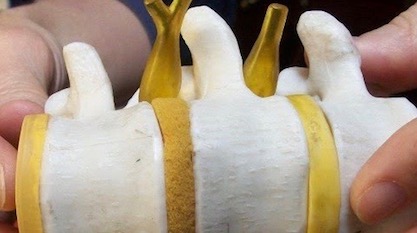 Intelligent Design
Intelligent Design
 Medicine
Medicine
Darwin Double-Crossed: The Design of the Human Nervous System


Editor’s note: Dr. Simmons is the author of What Darwin Didn’t Know and Billions of Missing Links. He is a Fellow with Discovery Institute’s Center for Science & Culture.
Evidence of intelligent design is easily found in the human nervous system.
The stem cells in the brain of every human embryo create trillions of neurons (nerve cells). Each cell comes with its own pre-determined destination and one or more specific purposes. They migrate by locomotion (somewhat like an amoeba moves) and translocation (somewhat like pulling on a rope with a grapple at the other end). Hundreds of thousands of these cells migrate at the same time to all areas of the brain; many can be tracked by real-time imaging. This is a massively coordinated event that smacks of intelligent guidance and design. But that’s only the appetizer.
After these cells reach their respective destinations, they connect with dozens or more of other neurons via fingerlike extensions called dendrites (tiny branches coming off medium branches coming off large branches of nerves). Hundreds reach out in different directions, each carrying several dozen chemical messages that can be adjusted. Meanwhile, the axon portion, a taillike appendage on the neuron, can stretch the length of the spinal cord or take a short jaunt to the face. This part of the neuron receives information.
Except for cranial nerves, motor nerve cells extend down through the spinal cord, and deliver instructions to skin, bone, joints, muscles, and organs throughout the body. Sensory nerve cells return information about pain, temperature, pressure, and vibration.
Not by Accident
Our skin and our insides are laced with an invisible, highly sophisticated, selective, neurological netting. Not by accident, different places on the body are more sensitive than others, including the lips, the outer edges of the sexual organs, and the anus; different parts of the body may have different receptors, such as the brain, which does not feel pain.
Nothing about our neurological system can be explained by billions of accidental occurrences, that is, the combination of mutations and natural selection. If you believe that there was enough time since the formation of the Earth to accomplish these changes, then note that there are more changes needed than the number of days in 4.5 billion years. Maybe more changes than total hours. And that’s if every step were perfectly correct.
The Oddest Part
The oddest part, for me, however, is the twistings or crossovers found in our neurological system. They appear to be completely inexplicable. The most obvious twist occurs at the base of brain. It looks like a single braid of challah bread. Most of the motor and sensory nerves from the left side of the brain go to (and come from) the right side of the body; and most of the motor and sensory nerves from the right brain go to (and come from) the left side of the body. There’s no apparent evolutionary benefit for the crossing-over that I can find. I have my guesses as to why it happened, but, that said, they remain only guesses.
Some 400 to 500 million years ago, according to the standard evolutionary account, an unknown living species with nerves running down its front changed into a new species with nerve tracts running down the back. That’s quite a jump. To protect the nerves, these tracts were housed inside new, bony structures, the vertebrae. Not only was specific bone added, but it was appropriately shaped, lined up, able to twist and bend, with the individual vertebrae protected from banging against each other.
Why Did It Happen?
At the same time the positions of the heart and stomach flipped over. But other organs stayed put. It’s not like the owl that can turn its head 180 degrees. How did this happen? There’s no way it could have been achieved by unguided mutations and natural selection. And why did it happen? In the rare cases of situs inversus in which people have their heart and gastrointestinal tract on the “wrong side,” the spine is not affected.
Not only is it hard to believe that billions of crossovers, counting individual nerves, happened so suddenly and so perfectly, but, from an evolutionary perspective, there should be an explanation not only as to how but also as to why. Darwinists have none. If an ancient species simply twisted like that, one would expect to see all the nerve tracts crossing over, but they do not. Stand out exceptions are the nerves to the eyes (the optic nerves). Only half of each optic bundle crosses to the other side. Half of the right optic nerve and half of the left optic nerve go to each eye. This doesn’t happen with the nose or the ears. Other nerve tracts cross over at different levels along the spinal cord, such as the lateral cerebrospinal tract, which crosses a few levels above where it enters the spinal canal. These are not accidental turns.
One cannot twist a plastic model of the spinal cord in any fashion to recreate these different crossings. They defy Darwinian explanations. Nothing short of an intelligent designer, operating purposefully, could have arranged it.
Photo credit: Tomwsulcer [CC0], via Wikimedia Commons.
